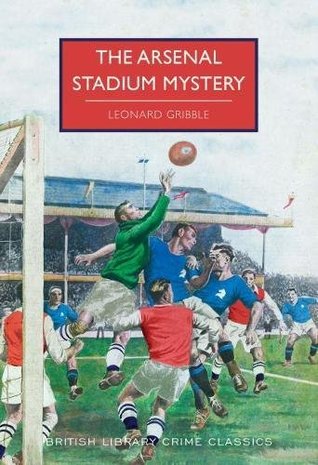The Arsenal Stadium Mystery, by the prolific if today little-known Leonard Gribble, was first published in book form in 1939 after appearing as a serial in the Daily Express. It is an intriguing and innovative detective story which uses as a peg the extremely popular Arsenal football club, resident at its old Highbury ground, and includes real players as well as manager George Allison (to whom the book is dedicated) among the characters. This 2018 British Library’s Crime Classics reprint is introduced by Martin Edwards.
John Doyce had just started playing right-half for the highly-competent (fictional) amateur side the Trojans in their match against the top-league Gunners. The plucky underdogs are doing well, Doyce having just levelled the score, but he collapses on the pitch during the second half with nobody near him. The final whistle marks both the end of the game, in Arsenal’s favour, and Doyce’s life. It is established he has been murdered by having poison administered, but how could it have happened when 70,000 pairs of eyes in the packed ground were watching the action?
The case is investigated by Gribbles’ series detective, the reliable Inspector Slade of the Yard, aided by his sidekick Sergeant Clinton. They have to unpick the inevitable complexities; Doyce had played with several of the Trojans in a previous team and been the business partner of another. Slade’s only clues to start with are a packet which arrived for Doyce in the dressing room, a mysterious blonde who made a fleeting appearance, and a clipping referring to a young woman who had died several years previously. Naturally he is quickly able to rule out the real individuals associated with the Arsenal.
The cast includes players and manager, backroom staff, and a gold digger who gets her comeuppance, but the emphasis is on the plot rather than depth of characterisation. Slade finds that many of his suspects have sufficient motive for murder, the late unlamented womaniser Doyce having been a thoroughly unpleasant fellow. Unsurprisingly, despite these obstacles he works out the identity of the perpetrator in the end.
The Arsenal Stadium Mystery is fun even for those who, like me, find the beautiful game a bore, and no knowledge of the sport is required to follow the investigation’s intricacies. The description of the match and the subsequent football elements, while creating atmosphere, are not allowed to dominate. The mix of murder and football proved very popular, and the book acted as a tie-in for a film, entertaining in its own right, directed by Thorold Dickinson and starring Leslie Banks as Slade.
With war just round the corner, The Arsenal Stadium Mystery conjures up a lost world of baggy shorts, ubiquitous smoking, and a relaxed attitude to crowd density on the terraces. Over and above the detective story it is worth reading for its slice of English social history, addressing as it does a hugely popular working-class pastime ignored by middle-class authors. This is definitely a masculine entry in a field – interwar detective novels – we tend unfairly to associate with ‘queens of crime’.

